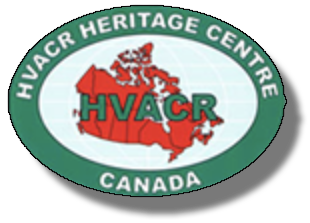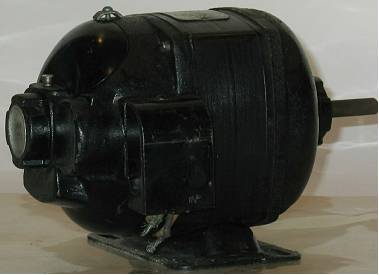Electric Motors – Single Phase, Repulsion Induction and Repulsion Motors
Classic mid 20th century, heavy duty, repulsion induction, brush lifting motor, dual voltage and mechanically reversible. Canadian made, it would characterize much of the Canadian experience through middle and latter years of the century, a period which saw massive growth in the demand for such high torque motors following W.W.II and frequency standardization. Yet, paradoxically, the period also witnessed the progressive demise of the technology, Leland [new and unused], Circa 1960. [See also ID# 308]
Features:
– Built-in well for the possible installation of “Klixon” motor overload protector with automatic reset.
– Shop tag in Howard Oliver’s hand writing, “checks OK, Jan 1975”
Technical Significance:
– With a built-in “well” making provision for “Klixon” inherent motor overload protector technology, this artifact is a marker of the advances made by mid century in personal and property protection for the FHP motor owners. By then, the inherent, automatic overload projector with automatic reset had become a mainstream technology, for which provisions were being built into the motor body, whether the particular application required it or not. Inherent, automatic overload motor protection was a universal truth for FHP motor design by the middle of the 20th century. It was yet another indicator of the new world of advances made through automation – as it existed in the mid 20th century.
– Canadian made, this motor would characterize much of the Canadian experience through middle and later years of the century, in high torque, FHP motor development. A period which saw massive growth in the demand for such high starting torque motors, typically for use on refrigeration equipment, which flooded the market in those years, following W.W.II and frequency standardization.
– Repulsion induction motor technology was above all a marvel of its time, a technology born of both science and the consumer market place, a classic formula for the innovation and diffusion of popular technology,throughout the balance of the 20th century and on in to the 21st. Scientifically, the work of Faraday and many others laid much of the theoretical foundations for electromagnetic devices, the marvel of the early 20th century [much in the same way digital devices became the marvel of the early years of the 21st]. The wonders made possible by alternating current energised, rotating magnetic fields and the electric and magnetic circuitry that made them possible would soon be exploited by those interested in their application in applied electro-motive technology, including Steinnmetz and others. [See References especially #I, 2, and 5]
– For the Canadian household and commercial refrigeration industry, pioneered by Kelvinator and Frigidaire, it would be a “just-in-time” technology, as well as an immensely enabling one – and what it enabled was considerable. Sir William Thompson, Lord Kelvin, had just set out the theoretical principles of the compression refrigeration, Carnot cycle [see Note #1]. But there existed no electro-motive devices with sufficient starting torque able to drive the compressor, making mechanical cooling practical for household and commercial uses – even for those who were otherwise able to enjoy the benefits of electrification. The push was on to develop such a device, the repulsion induction, single-phase motor would quickly follow.
– But paradoxically, by the mid 20th century the market for high torque, repulsion induction motors, for household and commercial refrigeration applications had peaked. A technology of its times, it represented immense achievement by early 20th century engineers and manufactures. Yet, as is typically the case, with the innovation, dissemination and popularization of technology come the seeds of its own demise. The very means by which its high torque performance had been achieved, through the use of an elaborate wound rotor, commentator and electrical brushes, made it costly, clumsy and noisy, as well as unsuitable for many embedded applications, such as hermetic refrigeration and air conditioning systems. Replacing the commentator and complex rotor windings with a “solid state, squirrel cage” rotor represented a giant engineering advancement. The development of capacitor start electric motor technology [see Classification 12.02] would now quickly replace repulsion induction technology for many applications, well before the end of the 20th century.
Industrial Significance:
– Well recognized for their performance, reliability and maitainability, the repulsion induction engineering designs employed by Leland Electric, Guelph Ontario, along with Wagner Electric Leaside would in many ways serve to characterizing best Canadian practice through middle and later years of the century.
– Because of the specialized nature of the technology, engineering and production costs, and the limited market, few companies would be seen as surviving in the popular, repulsion induction market beyond mid century.


